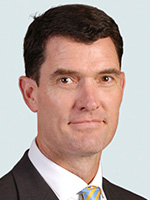When it comes to short-term investing, the phrase ‘lower for longer’ is a part of the treasurer’s vernacular that looks like holding its currency for some time to come. But can anything be done to optimise corporate cash without increasing risk?
Listen to podcast


Will Goldthwait
Vice President, Portfolio Strategist

About 20 years ago, Bank of Japan (BoJ) slashed its interest rate to 0% in an attempt to avoid deflation and to try to stabilise its fragile economy. For similar reasons, the so-called Zero Interest Rate Policy – or ZIRP – was adopted about ten years later by central banks in the US, the UK and Europe. In fact, the ECB went further and, as rates sank below zero (currently minus 0.5%), the acronym NIRP – for Negative Interest Rate Policy – surfaced.
In all these territories, it’s been this way ever since, and is likely to remain so until inflation starts hitting the ‘Goldilocks’ zone of 2% to 2.5%. In the key economies of the US, Japan, the UK and Europe, this looks like being some way off.
Its ageing population is more conservative in its spending habits, and the cost of living is expensive, so it’s harder to see growth pushing interest rates higher.
So is the best investment policy just to accept the status quo, riding it out for however long it takes? Or is there a better way to optimise company cash that does not involve chasing yield regardless of risk?
Will Goldthwait, Vice President, Portfolio Strategist at State Street Global Advisors, believes that treasurers can build strategies capable of deflecting the impact of an ongoing ZIRP/NIRP environment.
Reducing rates
For central banks like the Fed, BoJ, BoE and ECB, the notions of ZIRP and NIRP have been part of theoretical economic discussion for many years; they are not new phenomena. The objective of a central bank – and that might be managing inflation for the ECB, or employment and inflation for the Fed – will see the adoption of monetary policy tools such as these to try to boost their objectives.
Whether these policy tools work as well as expected is, to a degree, debateable says Goldthwait. With ZIRP/NIRP having been in situ for many years now, and counting, his inference is that they are not working. Central banks are still trying to stimulate their respective economies and all have at various points taken to using quantitative easing (QE) to direct-inject liquidity into the markets, using massive asset-buying programmes to try to stimulate that growth.
In the US, Goldthwait says this has worked to an extent, achieving low to zero rather than the ECB’s step beyond into negative rates. But then could it have been Fed intervention or a host of other variables that created this effect? It is, he notes, hard to say categorically if these specific rate policies work or not because, ultimately, there will be forces other than monetary policy impacting growth or inflation within an economy.
In Europe, the ECB has seen fit to revive QE, reinstating it in October 2019, after a ten-month gap, albeit at a slower pace than at its 2016-2017 peak. Others may follow, but can it really be sustained for long periods if all who are likely to will already have leveraged it? After all, Japan is a good example of QE longevity, its central bank having taken upwards of 50% of all Japanese Government Bonds (JGB)s out of the market, and even buying up certain equities.
But with Basel III’s post-2008 regulation on capital adequacy removing the concept of ‘too-big-to-fail’ for financial institutions (essentially, banks can more easily unwind instruments if they become stressed), Goldthwait sees central banks using QE to buoy-up a lot of debt in the market, potentially creating a new and unintended form of systemic risk.
When the Fed first tried to unwind QE, it created something of a repo market funding challenge back in September 2019. Its remedy was to implement a new purchase programme (it was not referred to as QE) to bring liquidity back to the market. Risk is evident if central banks want to unwind QE, notes Goldthwait. But, he adds, perhaps it is the new normal where central banks are “forced into being asset owners” because they cannot afford, when unwinding QE, to create another supply and demand mismatch.
Investor challenge
The continuation of the ZIRP/NIRP environment creates difficulties for investors. This is especially the case for those seeking some sort of return; chasing yield attracts extra risk. There is evidence of investors putting “just a little bit more risk in their portfolios” to try to mitigate negative rates or add a bit more yield. This, says Goldthwait, creates a knock-on effect.
Investors who previously stuck by money market instruments have been seen heading into the short-term bond space, those already there are looking at slightly longer durations, and those in fixed income are now looking to the equity market and so on up the scale of risk.
“Within all of these different asset classes, there are stories of how investors are awash in cash and have money to put to work,” he notes. This is perhaps unhealthy in the circumstances. Indeed, with the investors chasing some of the so-called ‘Unicorns’ (private start-ups valued at over US$1bn), he says it is revealing how certain valuations are being distorted to justify investment in these firms. “From that standpoint, QE is having an effect, but it is adding risk to a system where investors are chasing returns.”
Looking ahead
Planning by treasurers operating in a ZIRP/NIRP environment is obviously challenging. ‘Lower for longer’ may not continue ad infinitum, but then in Europe for example, it’s unlikely at this juncture that the ECB is about to spot inflation and raise rates. It’s unlikely too that it will suddenly see NIRP causing more harm than good. These matters will be answered at some point, but it’s going to take a while, says Goldthwait.
Meanwhile, whilst BoJ will maintain NIRP in the near-term, given how much and how hard it has tried to stimulate growth and inflation, he sees the demographics in Japan as more of a leading indicator. “Its ageing population is more conservative in its spending habits, and the cost of living is expensive, so it’s harder to see growth pushing interest rates higher,” he argues.
And the US has just concluded an easing cycle as an insurance against any downturn in economic growth. It cut rates three times by 25 basis points with the last cut happening in October. It also added liquidity to the money markets in order to stabilise repo funding yields. For Goldthwait, the chance of the four major central banks (Fed, BoJ, ECB, BoE) making any adjustment to monetary policy in the near term is low.
“I don’t think we are going to see any change in monetary policy from these institutions that will have any meaningful impact on negative interest rates in the near (one year) and medium (one-three years) term,” he comments.
The UK is slightly different. “It has done a good job in correcting some leverage issues in the market, and is balancing its budget better than some other developed markets,” notes Goldthwait. “If it wasn’t for the Brexit negotiations, I think interest rates there would be much higher.”
There’s a lot of disruption in the market right now and there can never be too much investment in technology; you just have to be careful about how that spend is allocated.
Taking action
Brexit imponderables aside, the first and most important action treasurers can take is to look at what their cash flows are, and then segment that cash, suggests Goldthwait. So instead of investing all cash in same-day liquidity funds or vehicles, it may be beneficial to separate what is truly needed as liquid cash from what could work a little harder but would be slightly less liquid. “It’s all about looking at the cash flows and risks in your investments and then potentially bifurcating that investment pool.”
Of course, the idea of cash segmentation has been around for several decades, but Goldthwait detects a “new energy” around it in the current environment. He notes, “when cash was earning 4%, 5%, 6% there wasn’t the urgency to pick up an additional 20-50 basis points. Now 20 basis points can be the difference between a negative or positive yield”. Indeed, amidst this environment, certainly in Europe, treasurers should be exploring all opportunities to try to mitigate negative yields, reviewing ultra-short strategies, and stress-testing these to determine the degree to which their current draw-down (change in NAV or negative impact to return) is sustainable.
Another element that treasurers must be keeping an eye on, says Goldthwait, is innovation in cash management. He feels that there is a need to stay ahead of technologies that can, for example, help the business manage certain deadlines, settlement restrictions or currency challenges.
“When I think about some of the new technology that’s coming out, especially blockchain or DLT-based, I can see this space becoming a lot more interesting over the next couple of years as fund managers and cash managers seek ways to use these tools,” he predicts. “There’s a lot of disruption in the market right now and there can never be too much investment in technology; you just have to be careful about how that spend is allocated.”
With ZIPR/NIRP likely bedfellows with most investors for some time to come, it is clear that treasurers have options open to them that do not significantly extend their risk. It just requires a bit of extra effort. As Goldthwait says, “where it used to be a straightforward decision to invest in short-term instruments, as yields have gone negative, so investors have to look a little harder”.
Listen to podcast